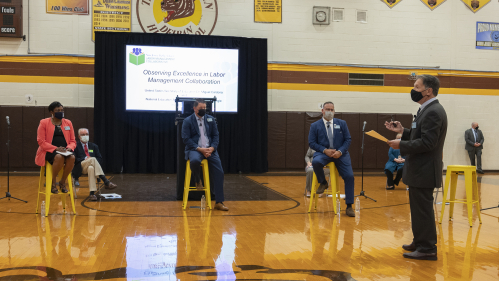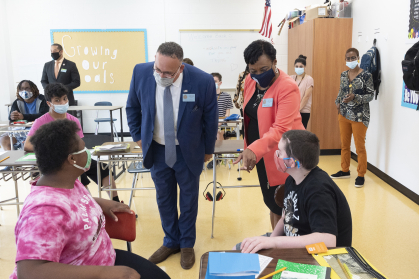National Education Leaders See How Rutgers Research Supports K-12 Student Success

U.S. Education Secretary Miguel Cardona and National Education Association President Becky Pringle visited New Jersey this week to learn more about an initiative that’s leveraging Rutgers research to improve student achievement and decrease teacher turnover in K-12 public schools.
The work is focused on collaborative school leadership, a model that encourages teachers, administrators, school boards, and unions to work together on everything from developing and revising curricula to updating instructional practices and policies. It’s an alternative to traditional top-down change.
“When you see something that’s working, people want in,” Cardona said. “You know it’s working not only because student success is increasing, but because educators are happy to be there. Principals are happy to be there. And it kind of connects them to the reason why they signed up for this profession in the first place.”
Saul Rubinstein, a professor in the Rutgers School of Management and Labor Relations, and Ph.D. student John McCarthy, now an assistant professor at Cornell University, began studying collaborative school reform 12 years ago. They surveyed more than 5,000 teachers in 450 school districts nationwide and tracked their responses against test scores.
In highly-collaborative schools, an additional 12.5 percent of students performed at or above the standard on English Language Arts tests and an additional 4.5 percent of students performed at or above the standard on math.
The researchers also found that teachers in highly collaborative schools expressed a stronger commitment to staying in the profession. And in a related case study from one large school district in California, collaboration reduced teacher turnover outright—even in the highest-poverty schools.
“It positively impacts student achievement, and it positively impacts teacher retention and commitment to the profession,” said Rubinstein, who’s now co-authoring a book with McCarthy on the findings. “These results are statistically significant. This is hard data.”
The research resonated with the leaders of New Jersey’s K-12 education organizations, who joined with Rutgers in 2013 to form the New Jersey Public School Labor Management Collaborative.
The New Jersey Education Association, New Jersey School Boards Association, New Jersey Association of School Administrators, and New Jersey Principals and Supervisors Association are working with Rubinstein and Rutgers Professor Charles Heckscher to help schools implement a collaborative model.
Delran, one of the pilot districts and the site of Cardona and Pringle’s visit on Wednesday, provides an early success story.

Working together, teachers and administrators created a new intervention team to assess skill levels and provide one-on-one remedial support to struggling kindergarteners. And since teachers noticed that some students came in at a disadvantage because their family could not afford pre-K, the district began providing free summer school to students based on academic need.
“Previous to our collaborative initiatives, they really spent a year behind the 8-ball,” kindergarten teacher Kathy McHugh said. “Not only did their struggles grow academically, but their self-esteem, their identity as a student, and their willingness to take risks were impacted. Now we catch them very early on. We’ve seen reading levels improve. We’ve seen writing levels improve.”
Achievement in literacy has grown for every demographic and subgroup in the district, McHugh said.
The Collaborative has grown to include 23 districts and 128 schools, covering nearly 500 administrators and more than 7,600 teachers statewide. Collectively, they serve 77,000 New Jersey students. The early results are so promising that the NEA is investing $3 million over the next three years to expand the initiative here and across the country.
“If we are going to create racially and socially just and equitable schools, the only way that can happen is if everyone in the system understands that it is their shared responsibility,” said Pringle, the NEA president. “When we say ‘every student,’ that’s the only way it can happen.”
Cardona, a former elementary school teacher and principal who was sworn in as President Joe Biden’s Secretary of Education in March, liked what he saw in Delran. He wants to find a way to elevate the collaborative model nationally.
“What you can’t see, you can feel,” Cardona said. “You feel a culture of collaboration that I know, as an educator, is a critical foundation to student success. We’re seeing it here at all levels in New Jersey, and I couldn’t be more proud of what I saw today.”


